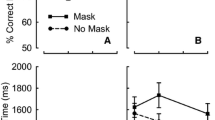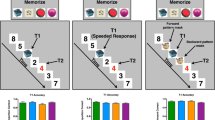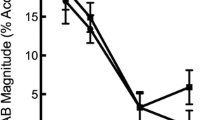Abstract
When two targets (T1 and T2) are presented in rapid succession, identification of T2 is often impaired (attentional blink: AB). The two-stage model accounts for the AB deficit by assuming that: (a) T2 is delayed in Stage 1 while Stage 2 is busy processing T1, and (b) T2 is vulnerable to masking while delayed. We report converging evidence for the model by evaluating these assumptions independently of the AB deficit itself. The results show that: (a) response times for T2 identification decreased as the lag between T1 and T2 was increased; (b) response times for T2 decreased across lags only if T1 was masked; and (c) accuracy of T2 identification increased as the stimulus-onset asynchrony between T2 and the trailing mask was increased.
Similar content being viewed by others
Author information
Authors and Affiliations
Additional information
Received: 4 February 1999 / Accepted: 26 July 1999
Rights and permissions
About this article
Cite this article
Zuvic, S., Visser, T. & Di Lollo, V. Direct estimates of processing delays in the attentional blink. Psychological Research Psychologische Forschung 63, 192–198 (2000). https://doi.org/10.1007/PL00008178
Issue Date:
DOI: https://doi.org/10.1007/PL00008178




